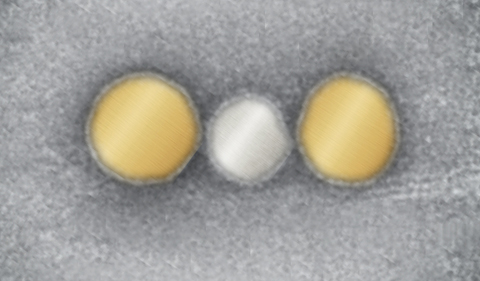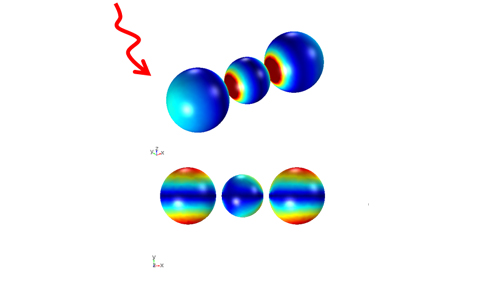
The transmission electron microscope image shows the structure, incorporating three nanocrystals and assembled on a DNA-origami carpet. The mediator in the middle: a silver nanocrystal between two gold nanocrystals ensures the ultrafast and almost loss-free transfer of the energy. Illustration: Liedl / Hohmann (NIM).
Three Ohio University physicists have collaborated with a three-member team of colleagues based in Germany to describe how multi-material chains made of silver nanoparticles can significantly reduce energy consumption when using plasmonic nanoparticles as energy and information transfer elements.
OHIO Post-Doctoral Researcher Dr. Lucas Besteiro, doctoral student Larousse Khosravi Khorashad and Distinguished Professor of Physics Dr. Alexander Govorov, have co-authored the paper “Hotspot-mediated non-dissipative and ultrafast plasmon passage” in the online journal Nature Physics, with colleagues Dr. Eva-Maria Roller, Claudia Pupp and Dr. Tim Liedl of the Physics Department and Center for NanoScience at Ludwig-Maximilians University of Munich.
Their innovative study provides a scheme that the researchers believe will help revolutionize the optoelectronics and computer design industries.
Besteiro and his co-authors designed and built a kind of mini-test track of about 100 nanometers in length from three nanoparticles: two gold nanoparticles and a silver nanoparticle right in the middle. The Ohio group made computer simulations of energy transfer in this track, whereas the Munich group fabricated it using DNA origami and metal nanocrystals and then measured their interaction through light scattering. DNA origami is the nanoscale folding of DNA to create 2- and 3-dimensional shapes at the nanoscale.
The study and its implications for the future are described in the University of Munich press release.
Fiber optic networks are already using light to transport data quickly and without loss over long distances. The thinnest cables, however, have diameters in the micrometer range, since the light waves with wavelengths around one micrometer must be able to oscillate freely. A completely different system is therefore required for data processing on a micro- or even nanochip.
One possibility would be to transmit light signals via so-called plasmonic oscillations. A light particle (photon) stimulates the electron cloud of a gold nanoparticle to oscillate. This wave movement is propagated with a roughly ten percent of the light velocity over a chain of nanoparticles. Thus, two objectives are achieved: nanometer dimension and enormous speed. Energy consumption remains. In the case of a pure gold chain, this would be as high as in classical transistors.
Today’s computers are fast and small as never before. Thus the latest generation of transistors will have structure sizes of only ten nanometers. In order to become even faster and energy-efficient in these dimensions, light particles are likely to be switched and used in the computer soon instead of electrons.
“We show in our study that we can transfer energy over longer distances, faster and almost without loss,” says Govorov. “Since energy in nanocrystals is highly concentrated, such systems are very compact, allowing them to store and transfer information at the nanoscale distances. Our approach demonstrates that plasmonic nanoparticles have potential to be used as photon handling elements and as channels for coherent transfer of energy and information in future all-optical computing devices.”

Two computer simulations of optically-induced electronic charges on the surface of the nanocrystals are shown for two kinds of plasmonic oscillations. Plasmonic oscillations occur in nanoparticles made of metal (for example, gold, silver, or platinum) with a large number of mobile electrons inside. Using these oscillations one can transfer energy and information between two gold nanocrystals.
The Ohio physicists have further plans to develop the ultra-fast plasmonic energy transfer. “This idea may be used in a variety of ways, opening different research avenues related to energy efficient applications,” says Besteiro. Khosravi Khorashad adds, “We predicted this low-loss energy transfer and then were thrilled to obtain excellent agreement through the experiment!”



















Comments